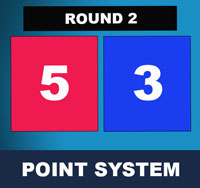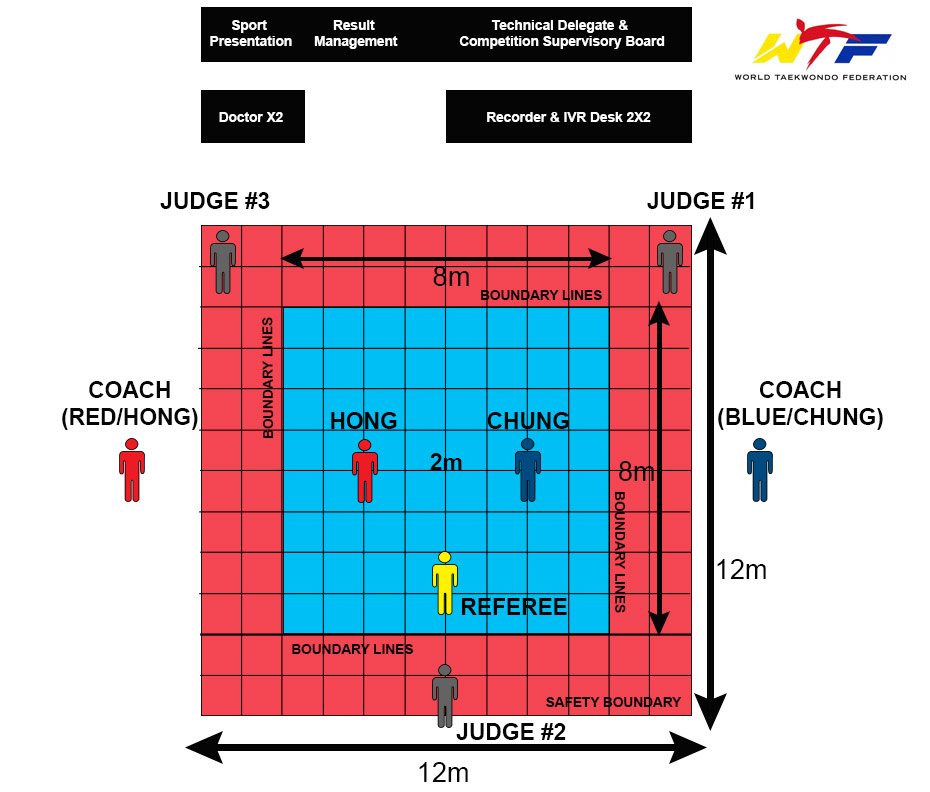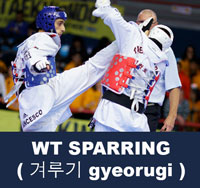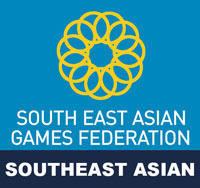Taekwondo 태권도Taekwondo Preschool
In some schools, permission to begin sparring is granted upon entry. The rationale for this decision is that students must learn how to deal with a fast, powerful, and determined attacker. In other schools, students may be required to wait a few months, for safety reasons, because they must first build the skills they would ideally employ in their sparring practice. View Taekwondo Sparring »

World Taekwondo (WT) Tournament Point System
Full Contact Sparring ( 겨루기 gyeorugi )
Points are awarded for permitted, accurate, and powerful techniques to the legal scoring areas; light contact does not score any points. The only techniques allowed are kicks (delivering a strike using an area of the foot below the ankle) and punches (delivering a strike using the closed fist).
Scoring Areas
- Body: The blue or red colored area of the body chest protector ( 호구 hogu )
- Head: The area above the collarbone ( 쇄골 swaegol ) (ex. whole part of the head ( 머리 meoli ) including both ears and the back of the head)
The valid points are divided as follows.
- One (1) point for a valid attack on chest protector ( 호구 hogu )
- Two (2) points for a valid spinning kick to the chest protector ( 호구 hogu )
- Three (3) points for a valid kick to the head ( 머리 meoli )
- Four (4) points for a valid spinning kick to the head ( 머리 meoli )
Match score shall be the sum of points of the three rounds.
The referee can give penalties at any time for rule-breaking, such as hitting an area not recognized as a target, usually the legs or groin ( 샅 sat ). Penalties are divided into 'Warnings ( 경 고 gyeong-go )' and 'Deduction Penalty ( 감점 gamjeom )'. Two 'Warnings ( 경 고 gyeong-go )' shall be counted as an addition of one (1) point for the opposing contestant. However, the final odd-numbered 'Warnings ( 경 고 gyeong-go )' shall not be counted in the grand total.
At the end of three rounds, the competitor with more points wins the sparring ( 겨루기 gyeorugi ) match. In the event of a tie at the end of three rounds, a fourth "sudden death" overtime round, sometimes called "Golden Point", will be held to determine the winner after a one-minute rest period. In this round the first competitor to score a point wins the sparring ( 겨루기 gyeorugi ) match. If there is no score in the additional round the winner shall be decided by superiority as determined by the refereeing officials.
Until 2008, if one competitor gained a 7-point lead over the other, or if one competitor reached a total of 12 points, then that competitor was immediately declared the winner and the match ended. These rules were abolished by the World Taekwondo (WT) at the start of 2009. In October 2010 the World Taekwondo Federation (WTF) reintroduced a point gap rule. Under the new rule if a competitor has a 12-point lead at the end of the second round or achieves a 12-point lead at any point in the 3rd round then the match is over and the athlete in the lead is declared the winner. The World Taekwondo Federation (WTF) has since renamed itself to World Taekwondo (WT) in 2017.
Prohibited Acts and Penalties
1. Penalties on any prohibited acts shall be declared by the referee.
2. Penalties are divided into 'Warnings ( 경 고 gyeong-go )' and 'Deduction Penalty ( 감점 gamjeom )'
3. Two 'Warnings ( 경 고 gyeong-go )' shall be counted as an addition of one (1) point for the opposing contestant. However, the final odd-numbered Warnings ( 경 고 gyeong-go ) shall not be counted in the grand total
4. A Deduction Penalty ( 감점 gamjeom ) shall be counted as one (1) additional point for the opposing contestant.
5.1 The following acts shall be classified as prohibited acts, and Warnings ( 경 고 gyeong-go ) shall be declared.
- 5.1.1 Crossing the Boundary Line
- 5.1.2 Avoiding or delaying the match
- 5.1.3 Falling down
- 5.1.4 Grabbing, holding or pushing the opponent
- 5.1.5 Attacking below the waist
- 5.1.6 Butting or attacking with the knee ( 무릎 mureup )
- 5.1.7 Hitting the opponent's face ( 얼굴 eolgul ) with the hand
- 5.1.8 Uttering undesirable remarks or any misconduct on the part of a contestant or a coach
- 5.1.9 Lifting the knee ( 무릎 mureup ) to avoid a valid attack or impede the progress of an attack
5.2 The following acts shall be classified as prohibited acts, and Deduction Penalty ( 감점 gamjeom ) shall be declared.
- 5.2.1 Attacking the opponent after “Kal-yeo”
- 5.2.2 Attacking the fallen opponent
- 5.2.3 Throwing the opponent by grabbing or hooking the attacking foot in the air or by pushing the opponent with the hand
- 5.2.4 Intentionally attacking the opponent's face with the hand
- 5.2.5 A coach or a contestant interrupting the progress of the match
- 5.2.6 Violent or extreme remarks or behavior on the part of a contestant or a coach
- 5.2.7 In case of using PSS, before each round of competition, the referee shall check whether any attempts were made to manipulate the scoring system and/or increase sensitivity of the sensing socks, or any other method, by the athlete. In the event that the referee finds intentional manipulation, the referee shall reserve the right to give Deduction Penalty ( 감점 gamjeom ) to the pertinent contestant and shall reserve the right to declare the violating athlete as the loser by penalty based on the degree of seriousness of the violation
6. When a contestant intentionally refuses to comply with the Competition Rules or the referee's order, the referee may declare the contestant loser by referee‟s punitive declaration after one (1) minute
7. When a contestant receives eight (8) Warnings ( 경 고 gyeong-go ) or four (4) Deduction Penalty ( 감점 gamjeom ), or in the event of any combination of Warnings ( 경 고 gyeong-go ) and Deduction Penalty ( 감점 gamjeom ) that add up to minus four points, the referee shall declare the contestant loser by penalties.
8. Warnings ( 경 고 gyeong-go ) and Deduction Penalty ( 감점 gamjeom ) shall be counted in the total score of the three rounds.
9. When the referee suspends a contest for the declaration of Warnings ( 경 고 gyeong-go ) or Deduction Penalty ( 감점 gamjeom ), the contest time shall not be counted from the moment of the referee's declaration of “Shi-gan‟ until “Kye-sok‟ is declared for resumption of the contest.
Sudden Deaths and Decision of Superiority
- In the event the winner cannot be decided after 3 rounds, a 4th round will be conducted.
- In case of a contest advances to a 4th round, all scores and penalties awarded during the first three (3) rounds shall be void, and the decision shall be made only by the result of the 4th round.
- The first contestant to score a point in the extra round shall be declared the winner.
- In the event that neither contestant has scored a point after the completion of the 4th round, the winner shall be decided by superiority as determined by the refereeing officials. The final decision shall be based on the criterion of superiority for the 4th round only.
- In case of using 4 refereeing officials (1 Referee and 3 corner judges), the referee can break the tie when the decision is tied with 2:2 among all refereeing officials.
Decisions
- Win by Knock-out (KO)
- Win by Referee Stops Contest (RSC)
- Win by final score (PTF)
- Win by point gap (PTG)
- Win by Sudden Death (SDP)
- Win by Superiority (SUP)
- Win by withdrawal (WDR)
- Win by disqualification (DSQ)
- Win by referee‟s punitive declaration (PUN)
Knock Down
- When any part of the body other than the sole of the foot touches the floor due to the force of the opponent‟s technique
- When a contestant is staggered and shows no intention or ability to continue
- When the referee judges that the contest cannot continue as the result of being struck by a legitimate technique
Procedures in the event of a Knock Down
When a contestant is knocked down as the result of the opponent‟s legitimate attack, the referee shall take the following measures.
- The referee shall keep the attacker away from downed contestant by declaration of “Kal-yeo (break)”.
- The referee shall first check the status of the downed contestant and count aloud from “Hana (one)” up to “Yeol (ten)” at one second intervals towards the downed contestant, making hand signals indicating the passage of time.
- In case the downed contestant stands up during the referee‟s count and desires to continue the fight, the referee shall continue the count up to “Yeo-dul (eight)” for recovery of the contestant. The referee shall then determine if the contestant is recovered and, if so, continue the contest by declaration of “Kye-sok (continue)”.
- When a contestant who has been knocked down cannot demonstrate the will to resume the contest by the count of “Yeo-dul (eight)”, the referee shall announce the other contestant winner by K.O.
- The count shall be continued even after the end of the round or the expiration of the match time.
- In case both contestants are knocked down, the referee shall continue counting as long as one of the contestants has not sufficiently recovered.
- When both contestants fail to recover by the count of “Yeol”, the winner shall be decided by the match score before the occurrence of Knock Down.
- When it is judged by the referee that a contestant is unable to continue, the referee may decide the winner either without counting or during the counting.
Sparring ( 겨루기 gyeorugi ) Competition Area

Risk of injury can be reduced by completing an effective warm up consisting of a heart raiser to get your pulse up, followed by sport specific dynamic stretches (stretches whilst moving). Please follow the guidance of a certified Master Instructor or trainer when doing sports related activities. Depending on the intensity of the exercise, cooling down can involve a slow jog or walk, or with lower intensities, stretching can be used. Cooling down allows the heart rate to return to its resting rate. View more information on Warming Up and Cooling Down ».
This article uses material from the Wikipedia articles "Warming Up" and "Cooling Down", which is released under the Creative Commons Attribution-Share-Alike License 3.0.
There are five tenets defined in the International Taekwondo Federation (ITF) and several more in World Taekwondo (WT).
Indomitable Spirit ( 백절불굴 baekjul-boolgool ): "To have indomitable spirit means to have the courage to stand up for what you believe in, no matter what odds you are up against, and to always give 100% effort in whatever you do." View Taekwondo Tenets »
RESOURCES
This article uses material from the Wikipedia articles "Sparring" and "Taekwondo Competition", which is released under the Creative Commons Attribution-Share-Alike License 3.0.











































